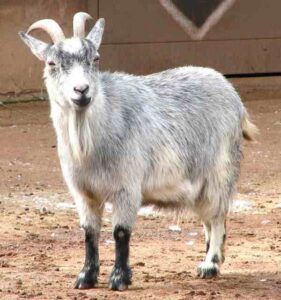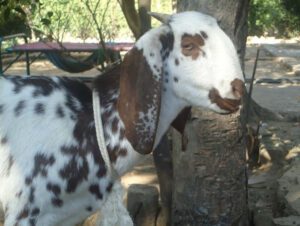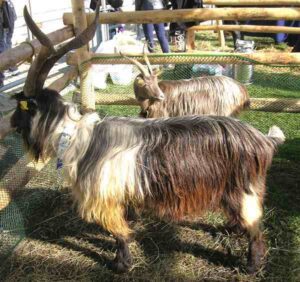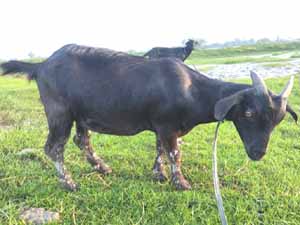The Kaghani goat is a breed of domesticated goats. It was originated from the valley of the Hazara district, and also found surrounding areas in NWF Province, Pakistan.
It is also known as Bakerwali goat in some areas. The home tract of the breed is Kaghan valley (Abbotabad, Kohistan, Mansehra and Swat).
The Kaghani goat is mainly used for meat production, and also good for cashmere fiber production. Read some more information about this goat breed below.
Kaghani Goat Full Information
History and Origin
The Kaghani goat is believed to have originated in the Khyber Pakhtunkhwa province of Pakistan. It is a crossbreed between the Beetal and Dera Din Panah goat breeds.
The breed is named after the Kaghani hills, where it was originally bred. The Kaghani goat is primarily raised for meat and milk production in Pakistan, and is highly valued for its high yield and adaptability.
Physical Appearance
Kaghani goat is a medium sized animal. Their body color is white, brown, gray or black. They have long hairs throughout their body.
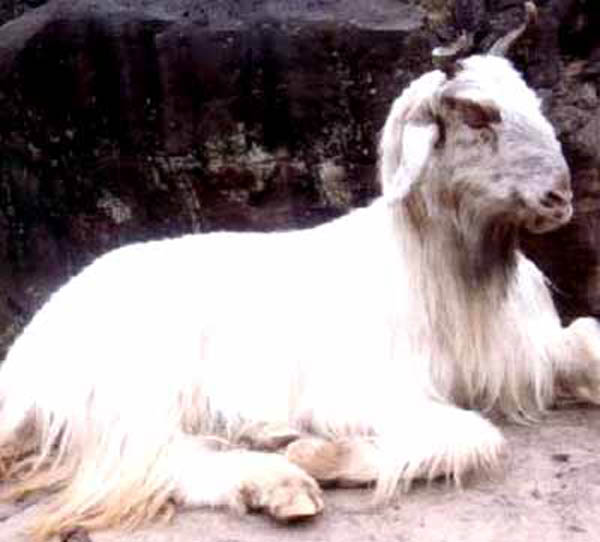
Both bucks and does usually have horns. And average body weight of the Kaghani bucks is up to 37 kg, and the does on average weight up to 32 kg.
Meat Production
The Kaghani goat is highly valued for its meat production, and is known for its tender, juicy meat. The meat of the Kaghani goat is considered to be of high quality, with a rich flavor and low fat content. The breed is also highly valued for its fast growth rate, with a male Kaghani goat reaching maturity in 8-10 months and a female reaching maturity in 6-8 months.
Milk Production
The Kaghani goat is also valued for its milk production. The breed is known to produce around 1-2 liters of milk per day, with a fat content of around 6-8%. The milk of the Kaghani goat is highly nutritious, and is rich in vitamins, minerals, and protein. The milk is often used to make a variety of dairy products, including cheese, butter, and yogurt.
Adaptability
The Kaghani goat is highly adaptable, and is able to thrive in a variety of environments. The breed is well-suited to the hot, arid climate of Pakistan, and is able to tolerate drought conditions and high temperatures. The breed is also able to survive on poor quality feed, making it an ideal breed for small-scale farmers.
Disease Resistance
The Kaghani goat is known for its hardiness and resistance to diseases. The breed is relatively disease-resistant, and is able to withstand a variety of illnesses and parasites. This makes it a low-maintenance breed, and is one of the reasons why it is popular among small-scale farmers.
Uses
This breed is raised mainly for meat production. But the breed is also suitable for cashmere fiber production.
Special Considerations
The Kaghani goats are good for small to medium scale farmers. They are good meat producers, and their meat conformation is considered to be medium to good. They also produce good amount of long hairs.
On average a Kaghani goat produce about 1-2 kg of long hair per year. They have an under coat of cashmere hair which is very expensive and used for pashmina fabrics. The does are not good milk producers.
On average they produce about 0.4-0.7 kg milk daily. Review full breed profile of this breed in the following chart.
| Breed Name | Kaghani |
| Other Name | Bakerwali Goat |
| Breed Purpose | Mainly kept for meat production. But also suitable for cashmere fiber production. |
| Breed Size | Medium |
| Buck | About 37 kg |
| Doe | About 32 kg |
| Horns | Yes |
| Climate Tolerance | All Climates |
| Coat Color | White, Brown, Gray or Black |
| Good for Stall Fed | Not sure |
| Rarity | Common |
| Country/Place of Origin | Pakistan |
The Kaghani goat is a highly valued breed of domestic goat that is primarily raised for meat and milk production in Pakistan. Its high yield, adaptability, and disease resistance make it an ideal breed for small-scale farmers.
The breed is also highly valued for its tender meat and nutritious milk, making it an important part of the agriculture industry in Pakistan. Overall, the Kaghani goat is a versatile and valuable breed that is well-suited to the needs of the Pakistani farming community.

